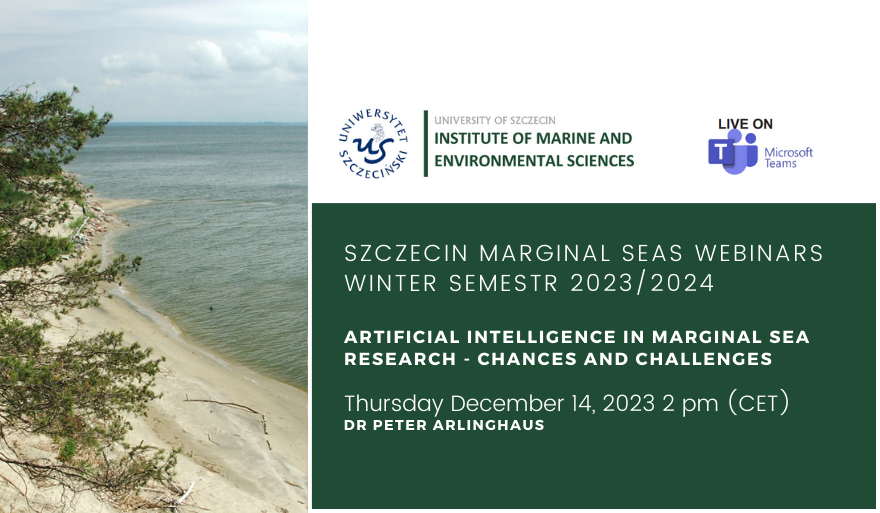
Spotkanie w ramach Szczecin Marginal Seas Webinars
Instytut Nauk o Morzu i Środowisku oraz Sekcja Geologii Morza Komitetu Badań Morza Polskiej Akademii Nauk i DDE Marginal Seas Task Group, zapraszają do udziału w kolejnym seminarium naukowym organizowanym w ramach cyklu Szczecin Marginal Seas Webinars, które odbędzie się w najbliższy czwartek 14 grudnia 2023 r.
Gościem Instytutu Nauk o Morzu i Środowisku US będzie Dr. Peter Arlinghaus z Institute of Coastal Systems – Analysis and Modeling, Helmholtz-Zentrum Hereon, Geesthacht, w Niemczech, który wygłosi referat pt. „Artificial Intelligence in marginal sea research – chances and challenges”.
Seminarium naukowe odbędzie się w formie online za pośrednictwem platformy MS Teams.
Kod dostępu: 2sc5rph
Abstract:
Artificial intelligence is an interdisciplinary tool that has reached and advanced all scientific and non-scientific fields such as economy, medicine or geosciences. Pioneering work was achieved in this field in the 1950s, however with the wide availability of computational resources, both in hard- and software, it has received strong recognition in the past ten years and has grown immensely in popularity. High-performance computing is now affordable for anyone and open-source machine learning frameworks like scikit-learn, PyTorch or TensorFlow enable accessibility for a large community. Thus, artificial intelligence was adopted in all fields of geo- and earth sciences such as remote sensing, weather forecasting, marine ecology, hydrodynamics, seismology, geochemistry or hydro-geophysics to name a few. In this presentation we will give a brief overview of the history and current state of artificial intelligence and machine learning. State of the art studies illustrating the capabilities of AI in geosciences will be presented from data driven to physics informed AI-models.
More specifically the application of AI in Marginal Sea Research will be introduced. Marginal Seas are lying at the transition zone between land and ocean and are thus subject to extensive human activities and stressor (pollution, land reclamation, tourism, shipping, fisheries, offshore wind farms) and multiple natural drivers (tides, waves, storm surges, sea level change) which are impacting the marine environment and ecosystem. All these drivers impact the development of the coastline which is globally inhabited by more than 600 million people. Since the evolution of coastline is highly dynamic it is important to identify and understand the processes guiding the change in order to develop sustainable management solutions to preserve and protect the coast.
One approach to do so is the use of remote sensing data. In this context an ongoing study will be presented which aims to classify and identify the coastline in the North and Baltic Sea, based on multispectral satellite images from the past 40 years (Sentinel-2, Landsat-5) employing machine learning methods. Automatic coastline classification based on machine learning is proven to be robust for sandy beaches on regional and global scales. However, sandy beaches only make around one third of the world’s ice-free shoreline. The rest consists of mudflats, cliffs, different types of vegetation and human constructions. Classification of these features is challenging. In order to improve the classification of other landforms a deep learning approach is utilized. The main challenge is to create an encompassing dataset, covering a large variety of different coastline types. Three methods are developed in order to reduce the effort of image labeling, namely 1. an active learning framework which allows high performance with strongly reduced amount of training data, 2. a sophisticated selection method to pick a valuable initial dataset for the active learning and 3. an unsupervised labeling method to accelerate the labeling process itself. Fundamental machine learning concepts like data normalization, clustering, dimensionality reduction and data fitting will be explained.







